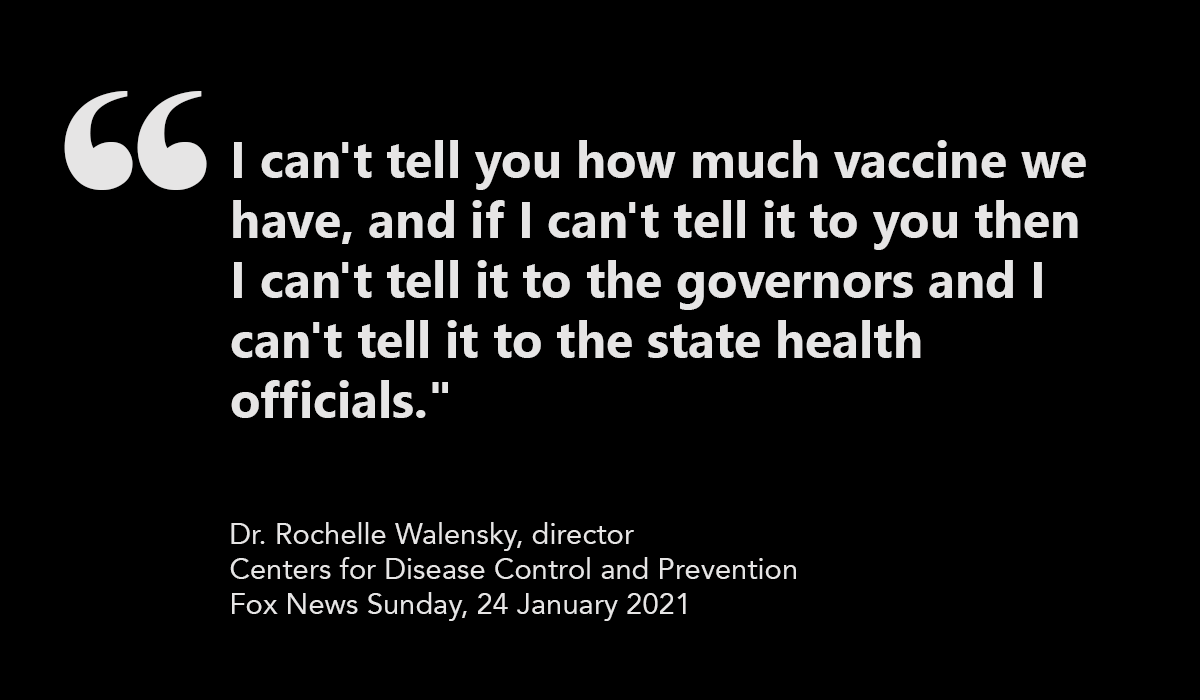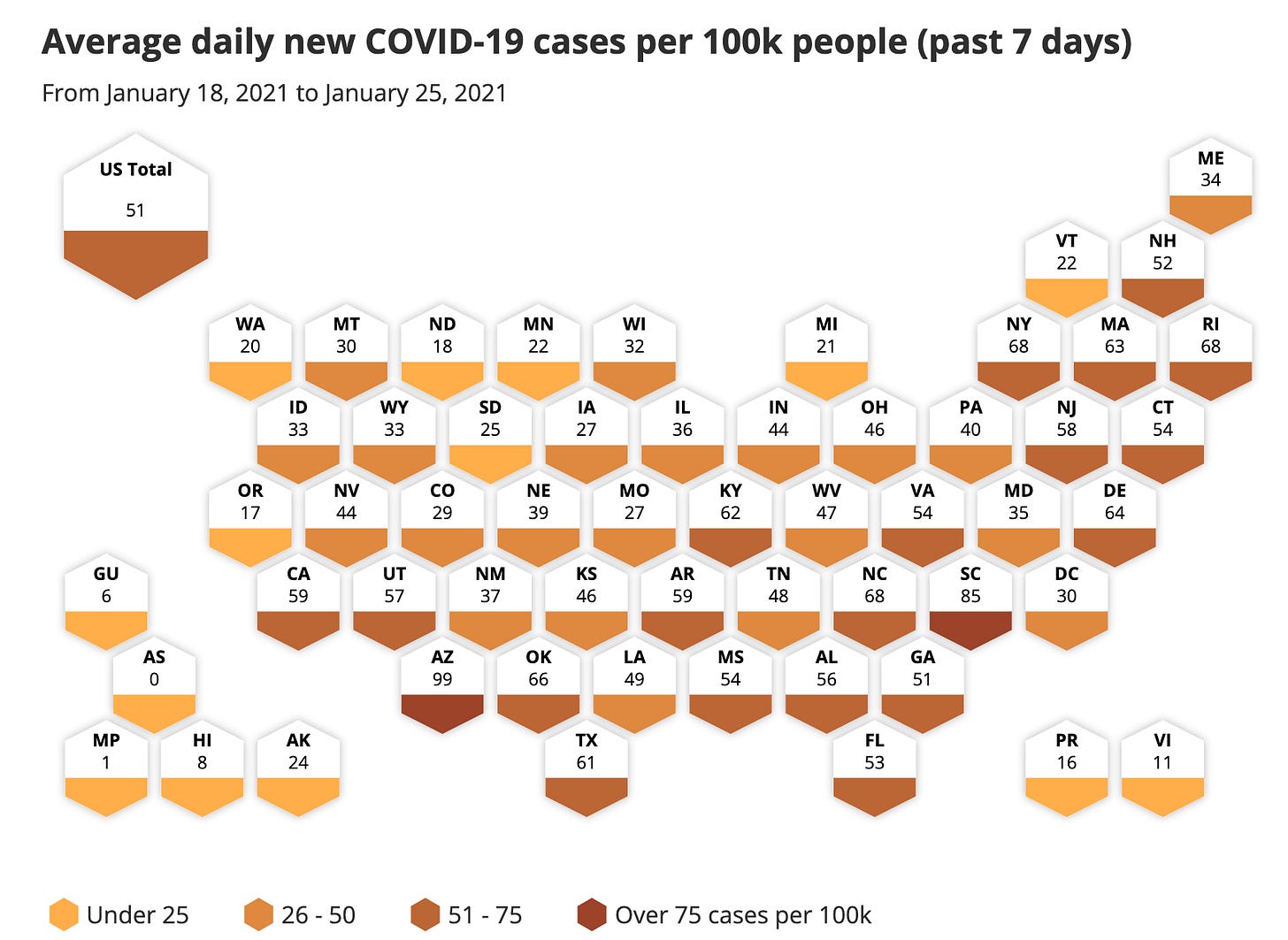COVID-19, Year 2: 📈 US hospitalizations hit six-week low : 25 January 2021
Transition reveals extent of vaccine mismanagement in the US; with 25 million cases now reported, at least 7.6% of the US population has been infected
On Monday, the Covid Tracking Project reported 109,936 patients in US hospitals due to COVID-19. That is the fewest number of patients since Monday, 14 December 2020, when we had 110,573 hospitalized patients. That’s also the day we began COVID-19 vaccinations. The peak hospitalizations: 132,474 on 06 January 2021.
This is welcome news on the national level. Some states, like Michigan, New Mexico and Oregon have seen a much steeper reduction in hospitalizations than other states, such as New Jersey, South Carolina and Utah.
The US still accounts for 1-in-4 global cases of COVID-19, with about 3% of the world’s population. We account for 1-in-5 deaths. At least 7.6% (25 million) of the US population has been infected with COVID-19; the percentage is certainly larger, given lack of testing initially and asymptomatic cases.
The attacks on September 11, 2001 claimed 2,988 lives. Our seven-day average death rate was 2,988 on 08 January 2021. For each day since then, sans one, the seven-day average has been more than 3,000 deaths. Distributed, defused, dismissed.
25 January 2021: vaccinations
I was surprised to receive a call from Seattle Cancer Care Alliance about 5 pm last Wednesday, asking me if I’d like to be vaccinated. In what seemed like a snap, I had an appointment for Friday morning.
The quasi-mass vaccination process at the Fred Hutchinson Research Center in Seattle was seamless, embellished with laughter and helpful nurses and staff. The entire process took about 30 minutes, from initial check-in to departure after my 15-minute observation. Side-effects over the weekend: minor swelling, a little fatigue and a headache that was exorcised with two Excedrin Migraine tablets.
I was stunned and yet resigned to learn Sunday that record keeping had not been a strong suit of the prior Administration. Appearing on Fox News Sunday, new CDC director Dr. Rochelle Walensky said that the federal government does not know how many vaccine doses it has on hand.
By mid-year, the country should have enough doses of our current vaccines (BioNTech-Pfizer and Moderna) to fully vaccinate 200 million people, assuming neither Pfizer nor Moderna run into manufacturing challenges.
On Thursday, the Biden Administration released its COVID-19 vaccination plan. It includes using the Defense Production Act (DPA) to produce “low dead space needles” which could be used to “extract a sixth dose of Pfizer’s vaccine from the vial.” The DPA may also be used to “ increase the supply of the lipid nanoparticles needed to make all mRNA vaccines” like the Moderna and BioNTech-Pfizer vaccines. It’s not clear how quickly either could be up and running and actually impact initial vaccinations and vaccine manufacturing.
Then Monday, President Biden upped his December goal of 100 million vaccinations in 100 days to 150 million. We have recently had days where 1 million vaccinations occurred (just not on a Sunday; 885,588 were reported yesterday). But will we have that many doses in hand to deliver?
Also on Monday, Biden extended travel bans that would have expired Tuesday. Travelers from South Africa who are not US citizens will not be allowed entry due to concerns about the coronavirus variant spreading there. Travelers are also banned from Brazil, Britain and 27 European countries.
Banning travelers from South Africa will not stop the spread of that variant. On Monday, New Zealand announced its first case of community spread in months, and it’s the South African variant (B.1.351).
“We can confirm that the strain of infection is the South African variant and the source of infection is highly likely to be a fellow returnee during the person’s stay at the Pullman hotel…
“The two people occupied rooms in close proximity to each other on the same floor of the Pullman hotel and I’m advised by officials that they’re confident that the infection was a direct one and that there’s no other missing link in between those two people.”
So far there are no news reports about the other person in the hotel. The woman who had two negative tests before being released from quarantine had returned home after traveling in Europe. From the NZ Ministry of Health:
The source investigation into how the Northland case was infected continues today at the managed isolation facility. This includes reviewing CCTV footage at the facility and looking at whether the infection may have occurred from person-to-person or surface transmission, or airborne transmission, including possibly the ventilation system.
New Zealand limits travel to citizens and travelers from Australia and the Cook Islands. Travelers from other parts of the world must have a critical reason for visiting.
Vaccine report, CDC 💉
Doses distributed to states: 41,418,325
Vaccinations given: 22,734,243
People who have both doses: 3,346,390
16 September 2020: “We’ll be able to distribute 100 million doses by the end of 2020 and a large number much sooner than that.”
08 October 2020: “We may have up to 100 million doses by the end of the year, enough to cover especially vulnerable population.”
15 December 2020: “We expect to have immunized 20 million of our American people” during the month of December. The Administration also pledged to distribute at least 40 million doses.
Vaccine map, Bloomberg
Vaccine overview
Since December 2020, “stringent” regulatory bodies (according to the World Health Organization) have approved three vaccines:
Creator, BioNTech (Germany); produced by Pfizer (US)
Creator, Oxford University (UK); produced by AstraZeneca (UK-Sweden)
Creator and producer, Moderna (US)
Others have been approved for distribution in their home countries, China and Russia. On Monday, Merck announced it would stop development of the two vaccines it had in process. Johnson & Johnson expects to report on its single-dose vaccine the end of this month. Novavax began its Phase 3 trial at the end of December.
Of the three household name vaccines, the Oxford-AstraZeneca vaccine “has the most to offer the world,” according to The Economist (09 Jan 2021). It is less expensive to produce and more robust than Moderna (which arrives frozen between -25°C and -15°C [-13°F and 5°F]) or BioNTech-Pfizer (which must be stored in an ultra-cold freezer between -80°C and -60°C [-112°F and -76°F]).
Originally, Oxford said the vaccine would be even cheaper: it planned to waive its rights and donate the vaccine to any pharmaceutical company. Instead, it flip-flopped.
[U]rged on by the Bill & Melinda Gates Foundation …. [Oxford] signed an exclusive vaccine deal with AstraZeneca that gave the pharmaceutical giant sole rights and no guarantee of low prices—with the less-publicized potential for Oxford to eventually make millions from the deal and win plenty of prestige.
The Gates Foundation donated $750 million to help manufacture the vaccine.
The Oxford-AstraZeneca vaccine has nine manufacturing nodes around the world. The two that have begun production are in Britain and India. Brazil began rolling out the Oxford vaccine, produced in India, last week.
What you may have missed in US reporting: COVAX, which is a global effort to vaccinate the world, not just people lucky enough to live in rich countries. It has fostered manufacturing capabilities, and pre-paid for vaccines, to be able to distribute 2 billion doses “fairly” by the end of 2021.
The Trump Administration, which had signaled its withdrawal from WHO, wasn’t interested in the global effort. We were notably absent, along with Russia. However, in addition to maintain US membership in WHO, the Biden Administration intends to join COVAX, according to Reuters.
Where are we today?
Summary, Johns Hopkins
US: 25,293,201 cases; 420,972 deaths
Global: 99,706,375 cases; 2,139,803 deaths
US Cases, Covid Tracking Project
Arizona continues to lead the country in per capita cases (99), followed by South Carolina (85). Then there’s a big drop: New York, North Carolina and Rhode Island (68); Oklahoma (66); and Texas (61).
👓 See COVID-19 resource collection at WiredPen / See all newsletters







